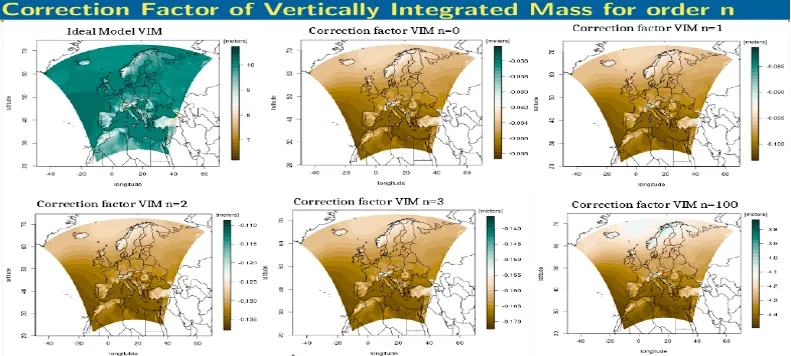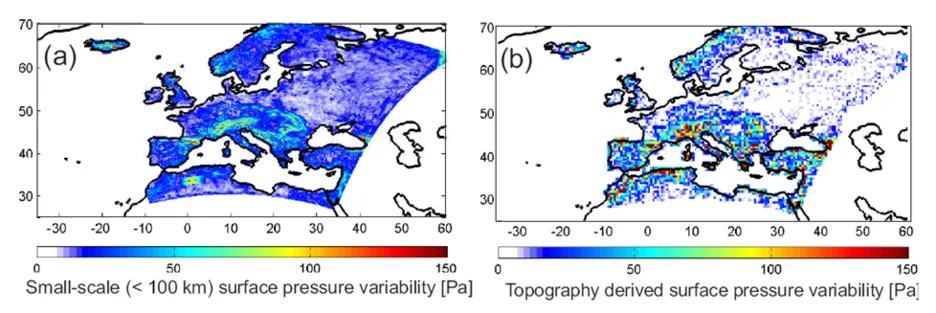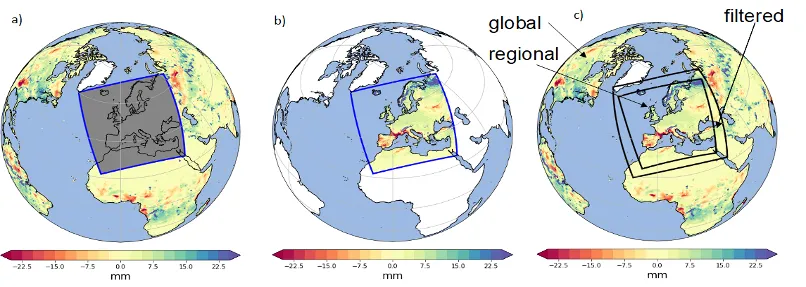
IP3: High-resolution Atmospheric-hydrological Background Modelling for GRACE/GRACE-FO – regional refinement and validation (HIRABAM)
PIs: Petra Friederichs, Jürgen Kusche, Andreas Hense, Michael Schindelegger (UBN)
Mercator-Fellow: Anna Klos (MUT)
Research Objectives
- Create consistent global data set of short-term atmospheric and hydrological mass variations with higher temporal and spatial resolution over Europe
- Study GRACE/GRACE-FO sensor data level improvements with this hybrid data set, and Level-2 product improvements by comparison with independent data
- Evaluate the results from (2) with respect to independent constraints on atmospheric/hydrological mass variability for use in future reanalyses
Innovations
- Quantification of spatial and temporal atmosphere signal that is currently not considered in GRACE data analysis
- Generation of ensemble of uncertainty, propagated to sensor level
- Validation of gravity models and impact assessment for atm. data assimilation
Selected Results
During the first phase, the focus of IP3 (High-Resolution Atmospheric-hydrological Background Modelling for GRACE/GRACE-FO – regional refinement and validation (HIRABAM)) was on (1) integrating high-resolution regional atmospheric modelling into developing Atmosphere Ocean De-aliasing (AOD) products, (2) high-resolution hydrological modelling for additional de-aliasing, and (3) validation studies. We have implemented a toolbox for 3D integration of atmospheric mass with an extension for nesting arbitrary regional into global models, for which temporal interpolation and spatial tapering/smoothing has been optimized. An update of the original ITG3D atmospheric de-aliasing method and data based on 1-hourly ERA5 input has been recently published. IP3 has generated ERA5-based A-coefficients refined by high-resolution COSMO-REA6 over Europe up to d/o 360, and a 5-member ensemble of atmosphere and ocean coefficients from ERA5 and the DEBOT ocean model for the test years agreed in this RU. In addition, a 32-member ensemble of H coefficients has been derived using the Community Land Model (CLM) forced with COSMO-REA6 over Europe at 1h time steps, with GRACE data assimilated to improve realism, and nested into the daily global hydrological model WGHM.
With respect to validation, IP3 has developed tools for the automated processing of data from the network of superconducting gravimeters (SGs) over Europe. A first comparison of GRACE and SGs in EOF-space is under preparation. We have improved the methodology of comparison and worked towards better assessing the sensitivity of GNSS at different timescales. Finally, IP3 looked at the potential of fibre-linked networks of optical clocks collocated with precise GNSS-sites for validating GRACE/-FO follower missions with very encouraging results.
While implementing COSMO-REA6 data, several potential inconsistencies in deriving A-coefficients were found which arise from (1) the perfect sphere assumption to realistic Earth models and (2) hydrostatic vs non-hydrostatic atmospheric models. The size of the effects related to (1) has been estimated at the level of local, grid point contributions within the COSMO-REA6 domain. Atmospheric densities in COSMO-REA6 are calculated in spherical shells relative to surface orography with the assumption of a constant sphere radius while the shell thickness varies. Shells can be “transplanted” to shells following the geoid such that the radial coordinate including the orographic height is correctly considered. A quantitative evaluation of biases in mean and variability based on COSMO-REA6 is underway. Results of a single day (June 2007) show the “pure” mass loading vertical integral on the top left expressed as equivalent water level, scaled with the ratio of the local radius to the mean radius of the earth. Remaining figures show the first order correction to the loading integral depending on the spherical harmonic degree.

The switch (2) has important advantages with respect to the vertical integration. The standard approach is based on the assumption of the atmosphere consisting of ideal gases dry air and water vapor in hydrostatic balance, and the vertical integral can be replaced by the surface pressure or by using the virtual (density) temperature. In non-hydrostatic models the densities of dry air, water vapor, liquid water and ice are explicitly calculated and can be integrated layer wise, directly without invoking the hydrostatic balance or ideal gas assumption. We found that currently almost all atmospheric models (including non-hydrostatic COSMO, WRF and ICON) apply the so-called shallow atmosphere approximation; this implies that selected tendencies of the prognostic atmospheric variables (like densities or velocities) are neglected. We suggest that while for current attempts to incorporate full deep atmosphere effects in calculating A-coefficients this might not be a large problem, e.g. when using reanalyses where the continuous synchronization with real world observations provides a correction. However, if utmost temporal consistency is required or observed gravity field variations shall be used in future re-analyses this may become important.
Analysis of atmospheric loading from COSMO REA6 for the test years concentrated on biases of the mean and variability, the latter derived from an EOF expansion of the hourly vertical loading integrals. Due to the extremely high dimensional COSMO data set tailored estimation procedures were implemented. Additionally, improved covariance matrix estimation methods are being developed jointly with other RU groups; these use the GLASSO (graphical Least Absolute Shrinkage and Selection Operator) or general shrinkage (weighted mean of the data-based covariance matrix vs a non-singular modelled covariance matrix). Once a non-singular covariance matrix description for COSMO-REA6 data set is available, sampling and generating realizations for ensembles of A-coefficients will be possible.

